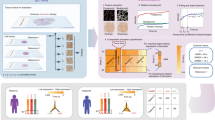Abstract
The paper presents an algorithm for quantification the degree of receptor expression to steroid hormones by automatic analysis of microscope images of immunocytochemical specimens. During experiments a high correlation between the results of the automatic analysis and visual expert assessment was shown and the possibility to apply the proposed algorithm to automate immunocytochemical analysis was confirmed.
Similar content being viewed by others
References
O. Brouckaert, R. Paridaens, G. Floris, E. Rakha, K. Osbome, and P. Neven, “A critical review why assessment of steroid hormone receptors in breast cancer should be quantitative,” Ann. Oncol. 24 (1), 47–53 (2012).
R. A. Walker, “Quantification of immunohistochemistry-issues concerning methods, utility and semiquantitative assessment I,” Histopathology 49 (3), 406–410 (2006).
C. R. Taylor and R. M. Levenson, “Quantification of immunohistochemistry-issues concerning methods, utility and semiquantitative assessment II,” Histopathology 49 (4), 411–424 (2006).
N. N. Volchenko and M. V. Savostikova, Atlas of Cytological and Immunocytochemical Diagnosis of Tumors (Reprocenter, Moscow, 2010) [in Russian].
S. Di Cataldo, E. Ficarra, and E. Macci, “Computeraided techniques for chromogenic immunohistochemistry: status and directions,” Comput. Biol. Med. 42 (10), 1012–1025 (2012).
R. Levenson, P. J. Cronin, and K. K. Pankratov, “Spectral imaging for brightfield microscopy,” in Spectral Imaging: Instrumentation, Applications, and Analysis II, Ed. by R. M. Levenson, G. H. Bearman, and A. Mahadevan-Jansen (Proc. SPIE, 2003), vol. 4959, pp. 27–33.
R. M. Levenson and R. Mansfield, “Multispectral imaging in biology and medicine: slices of life,” Cytometry A 69 (8), 748–758 (2006).
C. M. van der Loos, “Multiple immunoenzyme staining: methods and visualizations for the observation with spectral imaging,” J. Histochem. Cytochem. 56 (4), 313–328 (2008).
E. Y. Lam and G. S. K. Fung, “Automatic white balancing in digital photography,” in Single-Sensor Imaging: Methods and Applications for Digital Cameras (CRC Press, Boca Raton, FL, 2008), pp. 267–294.
J. Huo, Y. Chang, J. Wang, and X. Wei, “Robust automatic white balance algorithm using gray color points in images,” IEEE Trans. Consumer Electron. 52 (2), 541–546 (2006).
A. C. Ruifrok and D. A. Johnston, “Quantification of histochemical staining by color deconvolution,” Anal. Quant. Cytol. Histol. 23 (4), 291–299 (2001).
D. C. Allred, “Assessment of prognostic and predictive factors in breast cancer by immunohistochemistry,” Connection 9, 4–5 (2006).
K. S. McCarty, E. Szabo, J. L. Flowers, et al., “Use of a monoclonal anti-estrogen receptor antibody in the immunohistochemical evaluation of human tumors,” Cancer Res. 46 (8), 4244–4248 (1986).
M. E. Hammond D. F. Hayes, M. Dowsett, et al., “American society of clinical oncology/college of American pathologists guideline recommendations for immunohistochemical testing of estrogen and progesterone receptors in breast cancer,” Arch. Pathol. Lab. Med. 134, 907–922 (2010).
Author information
Authors and Affiliations
Corresponding author
Additional information
This paper uses the materials of the report submitted at the 9th Open German-Russian Workshop on Pattern Recognition and Image Understanding, held in Koblenz, December 1–5, 2014 (OGRW-9-2014).
The article is published in the original.
Dar’ya Aleksandrovna Dobrolyubova. Born 1990, graduated from Bauman Moscow State Technical University in 2013. Engineer-researcher, Educational and Scientific Center of Medical Technology, Bauman Moscow State Technical University. Fields of research priorities: automated microscopy of biomedical specimens, algorithmic support and software of digital pathology, methods and techniques for biomedical images processing and analysis. Author of more than 10 scientific publications (including 4 journal papers).
Tat’yana Andreevna Kravtsova. Born 1992. Graduated from Bauman Moscow State Technical University in 2015. Postgraduate student, Chair for Biomedical Technical Systems, Bauman Moscow State Technical University. Fields of research priorities: methods and algorithms of image processing and pattern recognition, methods and techniques of color measurements, transformation and correction, automated microscopy of biomedical preparations.
Ol’ga Aleksandrovna Samorodova. Born 1986. Graduated from Bauman Moscow State Technical University in 2009. Received candidate (PhD) degree in engineering sciences at Bauman Moscow State Technical University in 2013. Associate professor, Chair for Biomedical Technical Systems, Bauman Moscow State Technical University. Fields of research priorities: automated microscopy of biomedical preparations, biomedical image processing and analysis, biomedical statistics, computer-aided decision-making systems in medicine. Author of 60 scientific publications, including 13 journal papers.
Andrei Vladimorovich Samorodov. Born 1975. Graduated from Bauman Moscow State Technical University in 1999. Received candidate (PhD) degree in engineering sciences at Bauman Moscow State Technical University in 2002. Head of the Chair for Biomedical Technical Systems, Bauman Moscow State Technical University. Fields of research priorities: methods and algorithms of pattern recognition and multiclassification, automated microscopy of biomedical preparations, computer-aided decisionmaking systems in medicine, methods and technique for biomedical images and signals recognition. Author of more than 200 scientific publications (including 1 collective monograph and more than 30 journal papers).
Elena Nikolaevna Slavnova. Born 1960. Graduated from 2nd Pirogov Moscow State Medical Institute in 1985. Received candidate (PhD) degree in medical sciences at Herzen Moscow Oncology Research Institute in 1990. Senior researcher of the Department of Oncomorphology, Herzen Moscow Oncology Research Institute. Fields of research priorities: methods, systems and technologies of cytological cancer diagnostics and prognostication. Author of more than 200 scientific publications.
Nadezhda Nikolaevna Volchenko. Born 1949. Graduated from 2nd Pirogov Moscow State Medical Institute in 1974. Received candidate (PhD) degree in medical sciences in 1982. Received doctoral degree in medical sciences in 1999. The Head of the Department of Oncomorphology, Herzen Moscow Oncology Research Institute. Fields of research priorities: methods, systems and technologies of cytological cancer diagnostics and prognostication. Author of more than 200 scientific publications.
Rights and permissions
About this article
Cite this article
Dobrolyubova, D.A., Kravtsova, T.A., Samorodova, O.A. et al. Automatic image analysis algorithm for quantitative assessment of breast cancer estrogen receptor status in immunocytochemistry. Pattern Recognit. Image Anal. 26, 552–557 (2016). https://doi.org/10.1134/S1054661816030032
Received:
Published:
Issue Date:
DOI: https://doi.org/10.1134/S1054661816030032




